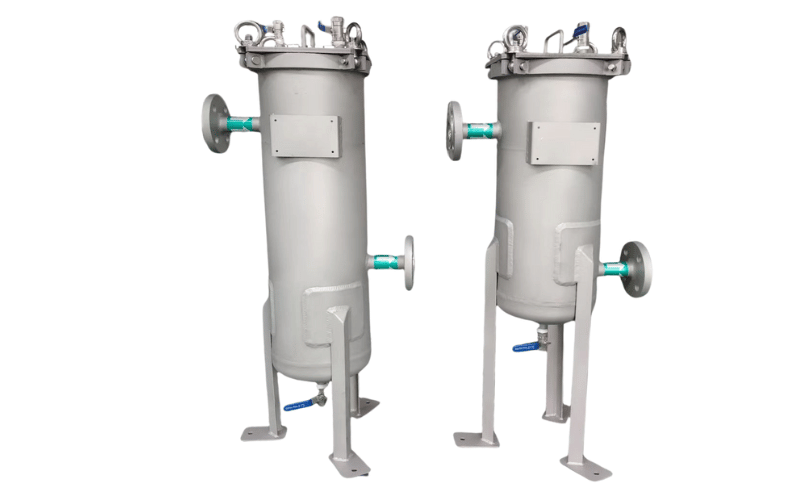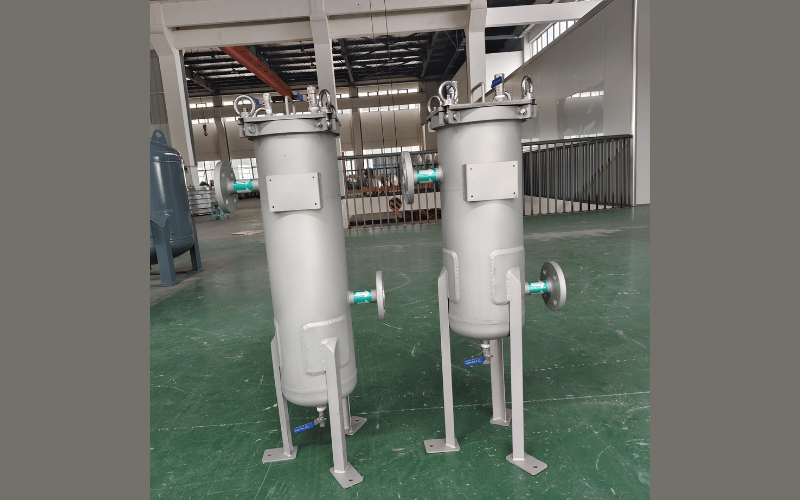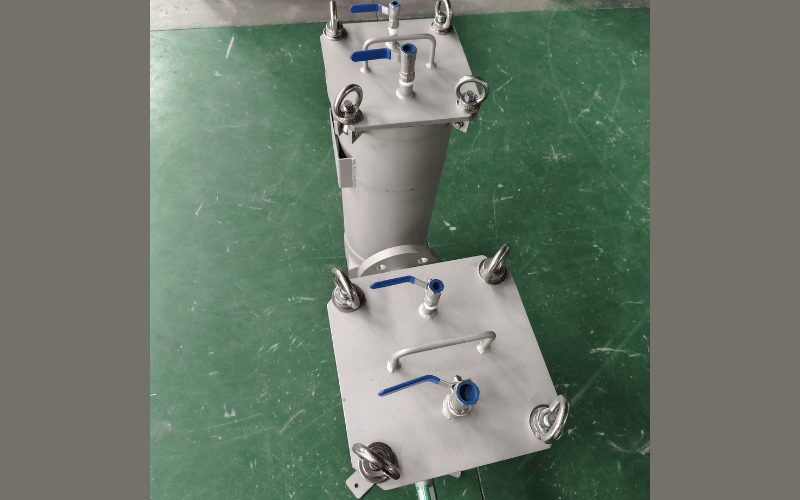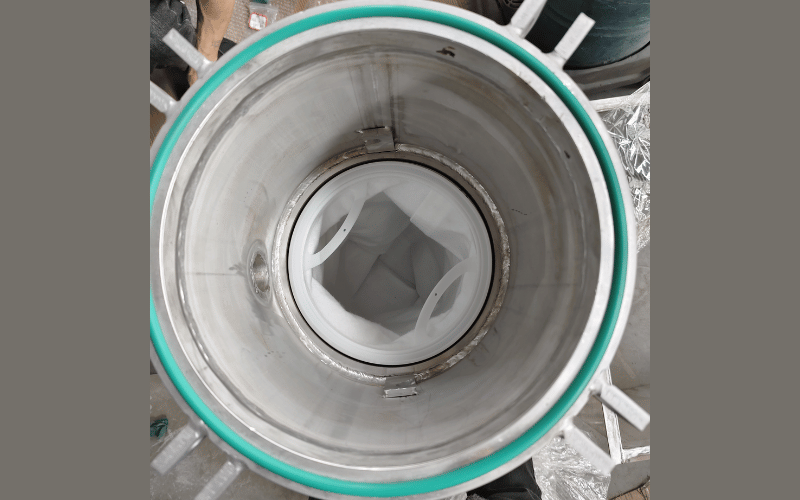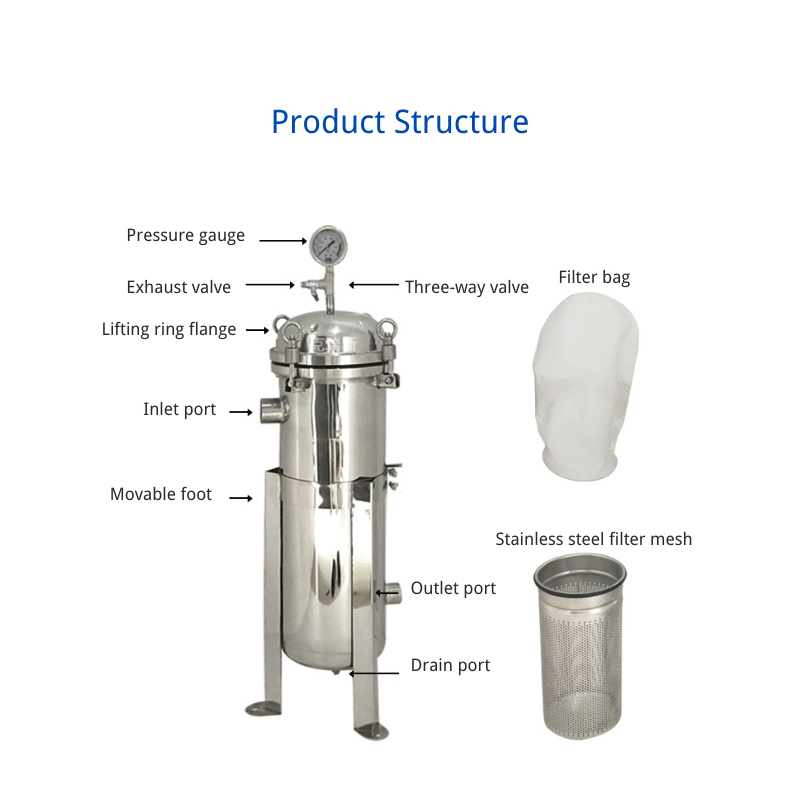Side Inlet Bag Filter Housing
Home » Filter Housing » Single Bag Filter Housing » Side Inlet Bag Filter Housing
Efficient Filtration | Long Service Life | Customizable Options
Boost efficiency and reliability in your filtration processes with our expertly designed Side Inlet Bag Filter Housing. Engineered for versatility and ease of use, this solution sets new standards in filtration performance.
Side Inlet Bag Filter Housing is a pressure-driven filtration device primarily composed of a filter housing, filter housing cover, quick-opening mechanism, and stainless steel filter bag reinforcement mesh. The filtrate enters the filter bag through the side inlet pipe of the filter housing. The filter bag is installed within the reinforced mesh basket. Liquid permeates through the required mesh size filter bag to produce qualified filtrate, while the filter bag retains particulate impurities. This machine allows easy filter bag replacement with minimal material loss during filtration.
Key Features & Benefits:
- Flexible Feed Connection
The side inlet design adapts effortlessly to your feed inlet connection, providing compatibility across various setups. - Easy Maintenance
A simplified structure enables quick and hassle-free filter cleaning, reducing downtime and improving operational efficiency. - Optimized for Precision
The housing’s minimal dead space ensures consistent filtration, making it ideal for applications in industries such as chemical processing, water treatment, and food and beverage production. - Superior Sealing
Featuring a single seal ring, the unit delivers dependable sealing performance, maintaining system integrity even under demanding conditions. - Enhanced Filter Bag Security
The three-point clamping plate secures the filter bag, ensuring leak-free operation and consistent results.
Whether you’re seeking reliability for long-term use or innovative design for specific filtration challenges, this housing offers a solution that rises to the occasion.
Technical Specifications
| Parameter | Details |
|---|---|
| Design Pressure | 0.6, 1.0, 1.6 MPa |
| Design Temperature | 5°C to 100°C |
| Sealing Type | O-ring and flat gasket |
| Sealing Material | Nitrile rubber, silicone rubber, fluor rubber (standard configuration: silicone rubber) |
| Flange Type | GB, HG, DIN, ANSI, JIS standard flanges; threaded connections; quick-release clamps, etc. |
| Filter Bags Available | PP, PE, nylon, PTFE, stainless steel, etc. |
| Surface Treatment | Matte bead blasting, mirror polishing, electrolytic polishing |
| Filter Precision | 1 μm to 1000 μm |
| Filter Housing Material | SS304, 316L, PP, carbon steel (all options can be fitted with a jacket) |
Side Inlet Bag Filter Housing Filtering Principle
1. Principle
The liquid to be filtered enters the filter bag from the top, flows from its inner surface to its outer surface, and retains particles and impurities inside.
2. Applications
Diesel fuel, edible oil, pre-water treatment, tap water, wastewater discharge, circulating water, etc. (Note: Only solid-liquid separation is possible; oil-water separation is not possible)
Product Structure
The Side Inlet Bag Filter Housing is a meticulously designed system, engineered for optimum filtration efficiency and durability. Each component has been thoughtfully incorporated to ensure seamless operation and reliability across diverse applications. Below is a breakdown of its key structural features:
- Pressure Gauge
Vent Valve - Tee
- Filter Bag
- Ring Flange
- Inlet
- Movable Foot
- Outlet
- Sewage Outlet
- Stainless Steel Filter
How to Maintain and Change Out Filter Bags in Side Inlet Housings?
Maintaining side inlet bag filter housings is essential to ensuring long-term efficiency and reliable operation. Proper maintenance not only maximizes the lifespan of your equipment but also reduces downtime and operational costs. Below, we provide a comprehensive guide covering essential procedures, the significance of O-rings in maintenance, and tips for cost-effective filtration solutions.
Step-by-Step Guide to Bag Change-Out Procedures
Changing out filter bags is a routine task that, when performed correctly, enhances your filtration system’s performance. Here is our detailed step-by-step guide:
Safety First
Before starting, ensure the system is fully depressurized and isolated from the fluid source. Always wear suitable personal protective equipment (PPE) to safeguard against fluid exposure and potential hazards.Release Pressure
Open the vent valve to release residual pressure safely. Verify that the pressure gauge reads zero before proceeding.Open the Housing
Loosen the bolts or clamps securing the housing lid and carefully lift the lid off. Ensure the sealing area remains clean to maintain proper sealing during reassembly.Remove the Used Filter Bag
Gently lift out the used filter bag, avoiding spillage of any trapped contaminants. Place the bag in a designated disposal container that complies with environmental and safety regulations.Inspect the Sealing Area
Conduct a thorough inspection of the O-ring or gasket sealing area for wear, damage, or debris. Wipe the surface clean to ensure optimal sealing during reinstallation.Install the New Filter Bag
Place a clean, appropriate filter bag into the housing, ensuring correct alignment with the support basket. Double-check that the bag sits securely and evenly to prevent slipping during operation.Reassemble the Housing
Carefully reinstall the housing lid, ensuring the O-ring or gasket is seated correctly. Tighten bolts or clamps evenly in a crisscross pattern to achieve uniform sealing pressure.Repressurize the System
Slowly reopen inlet and outlet valves while monitoring the pressure gauge. Check for leaks around the housing and make adjustments as necessary.
Performing this process correctly ensures your system operates seamlessly, minimizing disruptions and avoiding potential equipment damage.
Understanding O-Rings and Their Importance in Maintenance
O-rings are a critical component in side inlet bag filter housings, as the primary barrier preventing fluid leaks and maintaining system integrity. Here’s why they deserve special attention:
Sealing Performance
A well-functioning O-ring or gasket ensures a tight seal between the housing lid and body, preventing bypass and maintaining proper pressure within the system.Longevity and Compatibility
Selecting the right O-ring material (e.g., nitrile rubber, silicone rubber, or fluor rubber) ensures compatibility with the fluid being filtered and extends the seal’s lifespan. Regular inspection mitigates risks of wear, cracking, or deformation.Ease of Replacement
O-rings are designed for quick and easy replacement. Consistently replacing worn or damaged O-rings during maintenance prevents leaks and minimizes unplanned downtime.
Neglecting O-ring inspection can lead to operational inefficiencies, such as contamination, pressure loss, or even system failure. Being proactive in O-ring care is a small but vital step toward seamless operation.
Tips for Ensuring a Cost-Effective Solution
Optimal bag filter housing maintenance doesn’t have to be costly. By following these tips, you can enhance your system’s performance without overspending:
Use High-Quality Filter Bags
Investing in durable, high-performing filter bags minimizes the frequency of replacements and enhances filtration precision, saving time and resources in the long run.Plan a Maintenance Schedule
Adopting a proactive maintenance schedule helps you identify and address issues before they escalate. Regular inspections and timely replacements reduce the risk of costly repairs or system downtime.Monitor Operating Conditions
Closely monitor flow rate, pressure drop, and fluid contamination levels. Keeping your system within recommended operating conditions will extend the lifespan of components and prevent premature wear.Consider Spare Parts
Keeping spare O-rings, gaskets, clamps, and other essential components on hand ensures quick replacements and minimizes downtime during maintenance.Collaborate with Experts
Our team is always ready to provide support, whether helping you select the right filter bags or offering tailored maintenance advice for your application.
Implementing these practices can maintain cost efficiency while maximizing the performance and durability of your side inlet bag filter housing.
At the core of efficient filtration lies consistent maintenance and a thorough understanding of your system’s components. We take pride in designing reliable and user-friendly solutions, ensuring you achieve the best outcomes for your operations. For more guidance or support, contact our team—we’re here to help maintain your system’s excellence and ensure seamless performance.
What is the Cost-Effectiveness of Side Inlet Bag Filter Housing?
When choosing filtration solutions, cost-effectiveness is a critical factor to consider. At its core, cost-effectiveness exceeds the initial purchase price; it encompasses operational efficiency, durability, and long-term savings. Our side inlet bag filter housings are designed to balance affordability and exceptional performance. Below, we break down the key factors influencing their cost-effectiveness.
Comparing Costs: Single vs. Multi-Bag Solutions
Understanding the cost implications of single—and multi-bag filter housings can help you identify the most economical solution for your specific needs.
Single Bag Filter Housings
Due to their simpler design and smaller capacity, single-bag filter housings are typically more affordable upfront. These units are ideal for operations with intermittent or low-volume filtration requirements. Their compact size contributes to lower installation costs and easier maintenance, making them a budget-friendly option for smaller-scale operations.Multi-Bag Filter Housings
While multi-bag filter housings have a higher initial cost compared to single-bag units, they excel in large-scale applications where high throughput is essential. The ability to process greater volumes translates to fewer changeovers and reduced downtime, leading to significant operational savings over time. Investing in a multi-bag solution is often more cost-effective for industries managing heavy filtration loads in the long run.
We can help you select the right configuration for your budget and operational goals by evaluating factors like flow rate, filtration volume, and maintenance needs.
Long-term Savings from Using Durable Materials
The durability of materials used in our side inlet bag filter housings is significant in cost-effectiveness.
Corrosion Resistance
Our housings are constructed from high-quality materials, such as SS304, SS316L, and other corrosion-resistant alloys. These materials ensure the filter housing can withstand harsh operating conditions, including exposure to chemicals, moisture, and varying temperatures, without frequent replacements or repairs.Extended Service Life
Durable materials reduce wear and tear, minimizing the need for regular maintenance. For example, stainless steel housings offer exceptional longevity, making them a worthwhile investment for facilities that require consistent performance over extended periods.Multiple Filter Bag Options
The compatibility with various filter bag materials, including PP, PE, PTFE, and stainless steel, allows you to tailor the system to your process requirements while controlling costs. Selecting reusable or highly efficient filter bags further reduces material expenses.
We use robust materials and adaptable designs to help our customers achieve dependable performance with reduced upkeep costs, maximizing value over the product’s lifetime.
Evaluating the ROI of Investing in Quality Filter Housings
The return on investment (ROI) of a side inlet bag filter housing is not solely determined by its purchase price. When evaluating ROI, it’s essential to consider the long-term benefits contributing to savings and operational improvements.
Efficiency Gains
A high-quality filter housing supports consistent flow rates and optimal filtration performance. Fewer disruptions and higher productivity levels contribute to measurable financial benefits.Reduced Maintenance Costs
With a well-designed system that incorporates durable components like O-rings and robust housing materials, you can minimize unexpected repairs and reduce overall maintenance costs.Energy Savings
Our filter housings optimize energy consumption by maintaining proper flow and preventing pressure drops, leading to lowered operating costs over time.Compliance and Safety Assurance
Reliable filtration systems help industries maintain compliance with environmental and safety regulations. Avoiding fines or penalties for non-compliance adds substantial value to your investment.
With our range of side inlet bag filter housings, you can achieve a strong ROI by balancing quality, efficiency, and strategic planning for future scalability.
Investing in side inlet bag filter housings is a strategic decision, and our team is committed to helping you maximize cost-effectiveness at every step. Whether you’re managing a small operation or large-scale industrial processes, we provide tailored solutions that prioritize durability, performance, and savings. Contact us today for expert advice and customized recommendations—we’re here to help you make the most of your investment.
FAQs About Our Side Entry Bag Filter Housing
Q: What is your side entry series of bag filter housings?
A: Our side entry series is specifically designed for single bag filtration applications, offering easy access for maintenance and featuring options for side or bottom outlet configurations.
Q: What is the maximum pressure rating for your side entry series?
A: The side entry series is typically rated for a maximum pressure of 100 psi, making it a reliable choice for a variety of demanding filtration applications.
Q: What materials are used in constructing your filter housings?
A: Our filter housings are available in both carbon steel and stainless steel, including 304 stainless steel and 316L stainless steel options, to provide superior corrosion resistance for even the most challenging environments.
Q: What are the typical flow rates for single bag filters in your side entry series?
A: The single bag filters in our side entry series are designed to handle flow rates up to several gallons per minute (gpm), depending on the model and application requirements.
Q: What advantages does the multi-bag housing option in your side entry series provide?
A: Our multi-bag options deliver a cost-effective solution for high-volume filtration while maintaining a low-profile design that reduces housing height, ideal for installations in spaces with height constraints.
Q: How does the size of the filter bag affect system performance?
A: Larger filter bags, such as size 1 or size 2, allow for higher flow rates and longer service intervals, while smaller sizes are better suited for applications requiring precise filtration or lower flow rates.
Q: What is the difference between side and bottom outlet configurations?
A: Side outlet configurations enable lateral flow, whereas bottom outlet configurations support vertical flow. The choice depends on your system's space constraints and operational requirements.
Q: Are your side entry housings compatible with other filtration components?
A: Yes, our side entry housings are engineered for compatibility with a wide range of filtration components, providing flexibility in designing a filtration system tailored to your specific needs.


